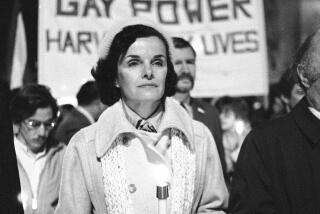Why We’re Fascinated With Patty Hearst
- Share via
The capture of Kathleen Soliah, one of last fugitive members of the Symbionese Liberation Army, seems to have opened a wound that most thought had long since healed. The dying gasps of the saga of the SLA and their 1974 kidnapping of Patty Hearst were heard only in dusty “on this day in history” pages at the backs of magazines and newspapers.
Yet, with Soliah’s capture, the story that gripped the nation some 25 years ago has quickly regained its hold.
As the Web master of a Web site devoted to Patty Hearst (https://www.pattyhearst.com/main.htm), I was excited to hear the news. As I read the comments in the site’s feedback forum, I began to gain a much clearer insight into the world’s fascination with Patty Hearst than I ever had before.
People love Patty, or love to hate her as the case may be, because she provided for the world a perfect paper doll to which any label could be applied. For the two unpleasant years following Watergate and the end of the Vietnam War, Patricia Hearst provided a heroine, a scapegoat, a villain and a victim.
For the radical leftist, Patty was proof that a privileged upbringing could indeed be overcome, and that there was a point to the “revolution.” To a nation of parents who sent their children to college in sweaters and skirts, only to have them return with American flags sewn to their backsides, she was a symbol of all that was wrong with the youth of the day. She proved that even children from the “best families” could go wrong, despite the best efforts of their parents. Those seeking tabloid titillation found in Patty confirmation of all their fantasies that young college girls need only be introduced to the world of free and “alternative” sex in order to convert a captive into a lover.
Even now, as my feedback forum is bombarded with hits and my e-mail box overflows, I see that the appeal has neither died nor changed much. Grizzled leftists, embittered by what they perceive as the lack of social change, enshrine Patty as the keystone to the revolution’s failure. They write of the SLA as if it were more than a small band of naive idealists who tokenized the poor and did little more than kill a decent politician and kidnap a 19-year-old girl.
Soccer moms write that they would have done just as Patty had in order to survive, sometimes adding, with an almost nostalgic tone, that they wished they had done more to protest injustice in their youth. Businessmen who call themselves “law-abiding citizens” state with enviable certainty that anyone who commits a crime must do the time.
Every post is impassioned, all contributors as certain of their particular brands of truth as if they had ridden every step of the way on Patty’s shoulder.
What is probably closer to the truth is that Patty Hearst is neither a hero nor a villain. She is a woman who found herself in a situation not of her choosing, who did everything she felt she needed to do to get through it alive. Not terribly scandalous, not good copy, but more like us and what we would do than we would probably care to admit.
More to Read
The biggest entertainment stories
Get our big stories about Hollywood, film, television, music, arts, culture and more right in your inbox as soon as they publish.
You may occasionally receive promotional content from the Los Angeles Times.









